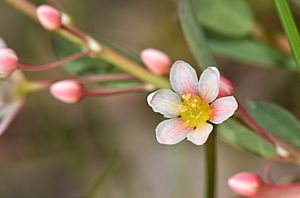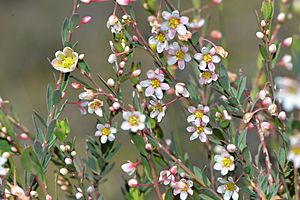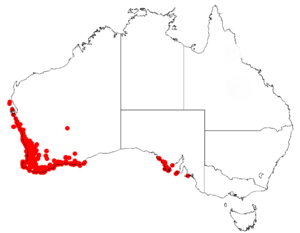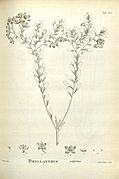Phyllanthus calycinus facts for kids
Quick facts for kids Phyllanthus calycinus |
|
|---|---|
 |
|
 |
|
| Scientific classification | |
| Genus: |
Phyllanthus
|
| Species: |
calycinus
|
 |
|
| Occurrence data from Australasian Virtual Herbarium | |
| Synonyms | |
|
List of synonyms
Clutia berberifolia Pax |
|
Phyllanthus calycinus, also known as false boronia or snowdrop spurge, is a small bush. It belongs to the plant family Phyllanthaceae. This plant usually grows between 20 centimeters (about 8 inches) and 1.2 meters (about 4 feet) tall. It often grows in sandy soils.
You can find Phyllanthus calycinus in parts of Western Australia and South Australia. Its flowers are white, cream, or sometimes pink. In Western Australia, you can see its flowers from June to January. In South Australia, they bloom from May to October.
What Does It Look Like?
Phyllanthus calycinus is a small shrub. Its leaves are usually normal, but sometimes they can be smaller. The plant has smooth branches.
This plant has both male and female flowers on the same plant. After the female flower is pollinated, parts of it grow larger. These parts, called sepals, grow to cover the developing fruit. The fruit is small, about 3 to 5.2 millimeters long and 5 to 6 millimeters wide. Inside the fruit are seeds. Each seed is about 2.5 to 3.9 millimeters long.
Plant Names and History
How It Got Its Name
The plant Phyllanthus calycinus was first officially described in 1806. A scientist named Labillardière gave it its name.
The second part of its name, calycinus, comes from Latin. It means "with a well-developed calyx." The calyx is the part of a flower that protects the bud. In this plant, the calyx grows larger to cover the fruit.


